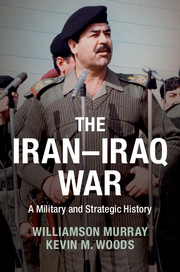Book contents
- Frontmatter
- Dedication
- Contents
- List of figures
- List of tables
- Preface
- Acknowledgments
- Note to reader
- 1 Introduction
- 2 A context of “bitterness and anger”1
- 3 The opponents
- 4 1980: The Iraqi invasion begins
- 5 1981–1982: Stalemate
- 6 Defeat and recovery
- 7 1983–1984: A war of attrition
- 8 1985–1986: Dog days of a long war
- 9 1987–1988: An end in sight?
- 10 Conclusion
- Appendix A Timeline
- Appendix B People
- Appendix C Place names
- Appendix D Order of battle
- Bibliography
- Index
- References
8 - 1985–1986: Dog days of a long war
Published online by Cambridge University Press: 05 September 2014
- Frontmatter
- Dedication
- Contents
- List of figures
- List of tables
- Preface
- Acknowledgments
- Note to reader
- 1 Introduction
- 2 A context of “bitterness and anger”1
- 3 The opponents
- 4 1980: The Iraqi invasion begins
- 5 1981–1982: Stalemate
- 6 Defeat and recovery
- 7 1983–1984: A war of attrition
- 8 1985–1986: Dog days of a long war
- 9 1987–1988: An end in sight?
- 10 Conclusion
- Appendix A Timeline
- Appendix B People
- Appendix C Place names
- Appendix D Order of battle
- Bibliography
- Index
- References
Summary
One of the important matters in battle is to stretch your imagination as far as you [can]; perhaps imagination allows us to discover things that we weren’t able to reach practically as we were overburdened with details. That is why our meeting today falls within this context. This political group … is to survey what is on the enemy’s mind; let us visit carefully the enemy’s mind, and let everyone speak his own mind without limitation and with liberty on the subject matter that he wishes to speak about … [Let us] recall events that took place and critique them, so we can decide how we [will] deal with the enemy in the next few months.
– Saddam HusseinBy early 1985, the opposing sides were beginning to resemble punch-drunk fighters. They had now fought for more than four years. Thus far in the war, their casualties had numbered in the hundreds of thousands. They had exhausted their holdings of foreign currency, while a fall in oil prices had exacerbated the economic difficulties both faced. For the Iraqis, the need to import tens of thousands of workers to replace those whom the regime’s massive mobilization had dragooned into the army compounded the difficulties (see Table 8.1). The attitudes of the two regimes toward the war, however, remained fundamentally different. For his part, Saddam could not understand Iran’s unwillingness to consider peace on anything other than its own terms. As he had commented to a Time reporter in 1982:
The chances for peace appear slim because Khomeini is a politician, not a man of principle. As time goes by he reveals his superficiality. The more he talks, the more he makes himself a laughingstock. I wish the whole world would read his statements to form an impression of this shallow devil. The actions he has carried out do not indicate that he is a rational person.
- Type
- Chapter
- Information
- The Iran–Iraq WarA Military and Strategic History, pp. 241 - 285Publisher: Cambridge University PressPrint publication year: 2014



